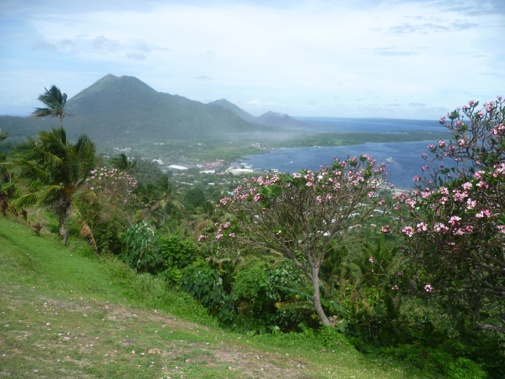
There is much to Rabaul that will leave you in a state of slack-jawed wonder. Situated on verdant New Britain Island in Papua New Guinea, Rabaul is synonymous with powerful forces. It has been defined and re-shaped by the ferocious battles of the Pacific War, and the staggering violence of nature. Cradled by the Simpson Harbour, which is one of the world’s deepest and most sheltered waterways, it is also a monstrous volcanic zone.
Twenty two years ago, you may well recall the twin volcanic eruption of Tavurvur and Vulcan, destroying the local airport and burying most of the town in heavy ash, with most buildings collapsing under the weight. The once lovely Garden City of Papua New Guinea was reduced to a desert-like landscape of brown and black ash. Thankfully, the overwhelmingly majority of inhabitants were evacuated and survived.
Mt. Tavurvur occasionally gives the locals a macabre reminder of its power with sporadic belches of ash cloud. Just recently, I paid a visit to Rabaul, where walking the wistful streets of the old town is like stepping into an apocalyptic film set. But Rabaul is anything but dead. It’s a truly fascinating encounter with the surreal moonscape of the volcanic ash and pumice field, the salvaged landmarks of old Rabaul and the rebuilt town.
The local market is the nerve centre of town life and the message that Christian missionaries brought to these shores in the 1800s remains a reaffirming source of strength for those who live in the shadow of these volcanos, with the local churches swelling for Sunday services. The indigenous people are Tolais, who are extremely resourceful at eking out a way of life, growing a plethora of crops and greeting tourists with smiles as wide as the Auckland Harbour Bridge.
A group of Australians and I, in hindsight fool-hardily, climbed up the side of hissing, steaming Mt. Tavurvur, awestruck by the sense of its living, breathing presence. Locals believe the volcano is infested with bad spirits, and they weren’t surprised that later in the day, Rabaul was rocking to a sequence of beefy 5mag earthquakes. ( Apparently it happens whenever visitors climb the mountain.)
At the foot of the volcano, on the Simpson harbour foreshore, enterprising Tolai children pluck incredibly yolky megapode eggs from nearby Matupit Island, and boil them in the bubbling hot springs, selling them to curious tourists for a dollar. It’s a magical sight. Pop into the Rabaul Museum, formerly the New Guinea Gentleman’s Club. It’s stacked with memorabilia of the tropical island’s legacy of natural and manmade disaster and drama.
Owned and operated by Susie McGrade, the iconic Rabaul Hotel resembled the Pompeii of the Pacific after the 1994 eruption. The owners spent months painstakingly digging the hotel out of the mounds of ash. It’s a terrific survivor to stop by for a tipple and tale or two.
Rabaul has seen its fair share of imperial arm-wrestles. The word Rabaul means mangrove in one of the local languages and it was the headquarters of German New Guinea, until Commonwealth troops seized it, during World War I. Administered by Australia, in January 1942, Rabaul was heavily bombed as thousands of Japanese troops rocked into town. By 1943 there were about 110,000 Japanese troops based in Rabaul and around 2000 local women were forced into prostitution.
The Japanese army dug an extraordinary honeycomb network of tunnels, as trusty hidey-holes from the Allied air forces. There are around 700km of tunnels in the hills, many of which can still be experienced today. I loved encountering the tunnels around Blanche Bay, where Japanese supply vessels and barges were spirited up into the tunnels on tracks. Accommodation and even hospitals operated within this cavernous network, built deep into the caldera walls.
Do not miss Admiral Yamamoto’s Bunker. This the wily Admiral who led the Japanese South Pacific campaign. He was eventually shot down by the Americans after flying out of Rabaul on an inspection tour to the neighbouring Solomon Islands. You can visit his underground command post, right next to the Rabaul Museum. Whenever the Allies were approaching, he would incarcerate himself in this dimly lit bunker, sometimes for weeks. I don’t know how he did it – I felt queasy after spending just five minutes in the bunker, just enough time to admire the map on the ceiling, illustrating his grandiose but ill-flatted plotting for world domination.
Take your Radio, Podcasts and Music with you









